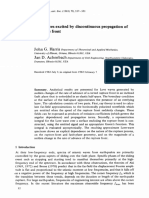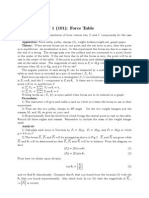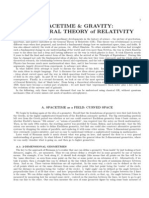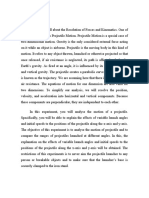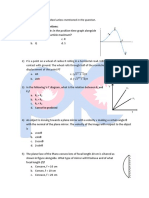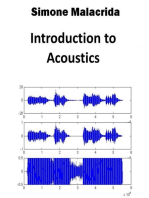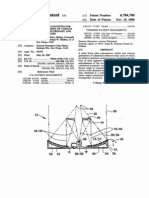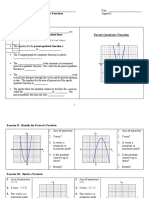Hodograph
Hodograph
Uploaded by
Mani KandanCopyright:
Available Formats
Hodograph
Hodograph
Uploaded by
Mani KandanOriginal Description:
Original Title
Copyright
Available Formats
Share this document
Did you find this document useful?
Is this content inappropriate?
Copyright:
Available Formats
Hodograph
Hodograph
Uploaded by
Mani KandanCopyright:
Available Formats
Hodograph: A useful geometrical tool for solving some difcult
problems in dynamics
Theocharis A. Apostolatos
a)
Section of Astrophysics, Astronomy, and Mechanics, National and Kapodistrian University of Athens,
Department of Physics, Panepistimiopolis, Zografos GR-15783, Athens, Greece
Received 29 January 2002; accepted 17 October 2002
The hodograph is very useful for solving complicated problems in dynamics. By simple geometrical
arguments students can directly obtain the answer to problems that would otherwise be complicated
exercises in algebra. Although beyond the level of undergraduates, we also use the hodograph to
calculate by variational geometrical techniques, the well-known brachistochrone curve, thus
illustrating this approach. 2003 American Association of Physics Teachers.
DOI: 10.1119/1.1527948
I. INTRODUCTION
In 1847, Hamilton
1
invented the hodograph and used it to
solve the famous problem that was rst attacked with success
by Newton; namely, to deduce the law of gravitation that
makes the planets revolve in elliptical orbits around the Sun.
Later, Maxwell
2
used the hodograph to introduce a short
variation of Hamiltons solution. Feynman resurrected the
geometrical technique of the hodograph to present an el-
ementary way to solve Newtons problem.
3
Sadly the
hodograph has almost entirely disappeared from most mod-
ern treatments of mechanics with the present emphasis being
on analytical methods for deriving the orbits for the inverse
square law. Also, the background of contemporary students
in Euclidean geometry is not as strong as that of students a
hundred years ago.
What is a hodograph? If the instantaneous velocity vectors
of a moving particle are translated to the same initial point,
the tip of the velocity vector traces a curve known as the
hodograph. What makes the hodograph a useful tool is the
fact that although Newtons law of motion is a second-order
differential equation for the displacement
d
2
r
dt
2
F/m, 1
it is a rst-order differential equation for the velocity
du
dt
F/m, 2
and thus the dynamics are more clearly reected by the
hodographic curve than by the trajectory itself see Fig. 1.
The hodograph that corresponds to planetary motion can
be shown to be a circle, and this property can be used to
prove that the orbit follows from the inverse square force law
see, for example, Ref. 2. In this paper, we will use the
hodograph for a much simpler force: the one produced by a
uniform eld, such as gravity near the Earths surface. Be-
cause du/dtgconstant, the velocity vector of a particle
for example, a projectile that is moving freely in the uni-
form gravitational eld traces a vertical line on which it
moves at a constant rate. In velocity space, the initial and
nal states of the projectile can be pictured as a triangle, one
side of which is vertical and linearly proportional to the time
of ight, while the other two sides have magnitudes equal to
the initial and nal velocities, with these velocities related to
each other by energy conservation. This triangle is the main
tool that will be used in Sec. II to demonstrate the beauty and
power of the hodograph technique. In Sec. III we use the
hodograph to solve the brachistochrone problem. Although
we will use the classical variational technique to solve the
problem, the use of the hodograph will make the analysis far
easier than the usual analysis, and the cycloidal curve will
arise much more naturally.
II. THE HODOGRAPH OF A PROJECTILE
As was outlined in Sec. I, the tip of the velocity of a
particle that is moving in a uniform force eld traces a
straight line parallel to the direction of the eld. Without loss
of generality, we will assume that the eld is that of uniform
gravity near the Earths surface. The equation of motion,
du/dtg, where u is the velocity of the particle and g is the
constant acceleration of free fall, can easily be integrated to
produce the well-known relation between velocities at differ-
ent times for uniform acceleration:
u
2
u
1
g t
2
t
1
. 3
We now discuss the physical content hidden in the geometri-
cal picture formed by the initial and nal velocity vectors
see, for example, the triangle of Fig. 2. The height of the
triangle (u
0
cos ) perpendicular to its vertical side is easily
identied as the constant horizontal velocity in general, the
velocity component that is perpendicular to the direction of
the eld. The vertical side, g(t
2
t
1
), of the triangle is pro-
portional to the time of ight. Therefore, the area,
1
2
g(t
2
t
1
)u
0
cos , of this triangle is proportional to the horizontal
distance, u
0
cos (t
2
t
1
), traveled by the particle during its
ight. This is the main idea that will be further explored in
Sec. II A.
A. The maximum range of a projectile
First consider a particle thrown with initial velocity u
0
from the edge of a cliff that is a height H above a plane
valley. We want to determine the shot angle that will make
the projectile land the farthest from the cliff. According to
our previous discussion, we must maximize the area of the
triangle ABC of Fig. 2 to maximize the horizontal distance.
Note that the two sides of this triangle have xed magni-
tudes; u
0
is the initial speed, and u
f
is the nal landing
velocity at the valley, which by conservation of energy is
u
f
u
0
2
2gH. This triangle assumes its maximum area
261 261 Am. J. Phys. 71 3, March 2003 http://ojps.aip.org/ajp/ 2003 American Association of Physics Teachers
when the two sides are perpendicular to each other. Then,
from the properties of similar triangles, it is easy to see that
is equal to the angle C
, that is,
tan
1
u
0
u
0
2
2gH
. 4
Equation 4 is valid even for negative values of H such as
when a particle is thrown from the bottom of a well as long
as the trajectory does not intersect the topography of the
ground. The maximum horizontal range achieved when a
projectile is shot at this angle is then easy to calculate. The
area of the velocity triangle E
ABC
is g/2 times the horizontal
distance. Thus
R
max
2E
ABC
g
u
0
u
0
2
2gH
g
. 5
For H0 we obtain the well-known value u
0
2
/g that corre-
sponds to 45 inclination angle see Eq. 4.
We next investigate a more general projectile problem. We
will assume that the particle is shot from a point on the
ground, the topography of which is described by the mono-
tonic function y(x), where x is the horizontal distance and y
is directed down see Fig. 3. Initially the particle is located
at (x0,y0). A trajectory that ends on the ground at
(x
f
, y
f
y(x
f
)) corresponds to a velocity triangle, the two
sides of which have magnitudes ABu
0
, and AC
u
0
2
2gy
f
, respectively see Fig. 4. If we keep the angle
between initial and nal velocity xed, then the intersec-
tion of the curves
f
1
ysin
u
0
u
0
2
2gy
g
6
Fig. 1. While the force vector points along the instantaneous center of
curvature of a particles trajectory, it is simply tangential to the hodographic
curve. Therefore, the connection between the hodograph and the force law is
much more direct.
Fig. 2. This triangle is formed by the initial and nal velocities of ight. The
vertical side of triangle ABC is the hodograph of motion, while the area of
the triangle is proportional to the horizontal distance traveled. The angle is
the initial shot angle that has to be optimized.
Fig. 3. A projectile shot at angle from the top of a hill, the topography of
which is described by the function y(x).
Fig. 4. The velocity triangle for a projectile that is shot from the top of a
hill.
262 262 Am. J. Phys., Vol. 71, No. 3, March 2003 Theocharis A. Apostolatos
(2/g times the area of the velocity triangle, and
f
2
yx y 7
the inverse of y(x) of the ground morphology, gives the
coordinates of the ground point if it exists where the par-
ticle will fall, given the angle between the initial and the nal
velocity of the trajectory. It is easy to see why this is so.
Because f
1
(y) equals the horizontal distance traveled by the
particle as was explained in the previous section, the inter-
section point of the curves f
1
and f
2
corresponds to the point
where the projectile trajectory meets the ground.
We will examine the three possible cases that exhaust all
possible downhill ground morphologies for which the initial
point is the highest one: a The graph of f
2
has only one
intersection point with f
1
regardless of the value of see
Fig. 5a; b f
2
(y) does not increase as fast as f
1
(y); con-
sequently, there is no intersection point for sin s
c
see Fig.
5b; c there are multiple solutions of the equation f
1
(y)
f
2
(y) for a range of , including the extreme case
90 see Fig. 5c.
In case a we can easily nd the maximum horizontal
distance, because f
1
(y) and f
2
(y) are both monotonically
increasing functions, and there is only one intersection point;
the higher the value of sin , the higher the value of x at the
intersection point. Therefore, we achieve the longest range
when 90, just as in the simple case analyzed previously
The optimal inclination angle can be estimated, given the
graphical solution for 90:
tan
1
u
0
u
0
2
2gy
, 8
where y
is the y coordinate of the graphical solution. We
can simplify the calculations that follow by introducing the
characteristic length :
u
0
2
2g
. 9
Then, we can express the optimal value of that is given in
Eq. 8 as
tan
1
1y
/
. 10
Also, because the graphical solution assumes that f
1
(90)
(y)
f
2
(y) where the superscript
(90)
refers to the angle be-
tween the initial and nal velocities, that is,
u
0
u
0
2
2gy
/gx
,
1
y
2
, 11
and thus tan 2/x
, which can be transformed after some
algebra to
tan 2x
/ y
. 12
But x
/ y
is the cotangent of the inclination angle of the line
connecting the initial and nal points. This form of the solu-
tion gives a straightforward answer to the case where the
ground has constant slope b: the particle should be shot at an
angle 45/2.
In case b there is no graphical solution for sin s
c
, and
the solution that corresponds to sin s
c
where the two
graphs f
1
(y) and f
2
(y) are tangent to each other seems to
give the required answer. However, this assumption is not
true. The graph of f
1
(y) for slightly lower values of sin
intersects the graph of f
2
(y) at even higher x. The appar-
ently paradoxical fact that the plot of f
1
(y) goes under the
ground there is a region of y where f
1
(y)f
2
(y)] does not
mean that the trajectory penetrates the ground. Remember
that f
1
(y) does not describe an actual trajectory, because
( f
1
(y), y) is the locus of points of different trajectories,
where the angle between the initial and nal velocities is
held xed, while for an actual trajectory this angle varies
from point to point. As long as the angle
2
the angle be-
tween the nal velocity and the horizon is larger than the
inclination of the ground, the intersection of the plots of f
1
and f
2
corresponds to arrival at this point from above the
ground, while if the angle
2
is smaller than the inclination
of the ground, the intersection point corresponds to arrival
from beneath the ground, and thus, it has no physical mean-
ing. For example, at the critical value of (sin
c
s
c
),
where the two curves just touch each other, it is easy to show
see Ref. 4 that the slope of the ground is not equal to
2
.
If
c
/2, then the ground at the intersection point is
steeper than the trajectory of the projectile, while, if
c
/2, then the trajectory is steeper. Therefore, this graphical
solution point cannot be reached with the oblique angle so-
lution of sin
c
s
c
, but it can be reached with the corre-
sponding obtuse angle solution. In the latter case, even
higher values of will yield even longer range. The longest
range will be obtained at an obtuse angle
see Fig.
5b, that at the intersection point the slope of the ground
equals the inclination of the nal velocity,
2
.
Finally, in case c, where there are multiple solutions for
90, the longest range x
that the projectile can reach is
the rst the one with the smallest y
value graphical solu-
Fig. 5. The graphical solution of the maximum range for the three cases a,
b, and c are shown in the corresponding diagrams a, b, and c. In case
b, the solution is not the one that corresponds to the critical sin s
c
value, but rather, as discussed in the main text, the one with even lower
sin value (s
). Diagram d shows the graphical solution when the pro-
jectile is shot from the deepest point. The black lines correspond to the
simple case of continuously rising ground, while the gray lines correspond
to more complicated ground morphologies, for example, with cavity forma-
tions.
263 263 Am. J. Phys., Vol. 71, No. 3, March 2003 Theocharis A. Apostolatos
tion of f
1
(90)
(y)f
2
(y), because the projectile cannot go
any further than the curve f
1
(90)
(y). Thus, no other graphical
solution can be achieved, because otherwise the projectile
would penetrate the ground see Fig. 5c. Again, the opti-
mal inclination angle can be calculated exactly as in case a.
For completeness, we describe the case where the initial
point is now the lowest point on the ground. Again, we can
resort to the graphical solution by extending the graph f
1
(y)
to y0. Depending on the ground morphology, we can nd
the maximum x
by trying various values of . For ground
that is constantly uphill, it is obvious that the maximum
range will be accomplished for 90 see the black curves
in Fig. 5d. If there are cavity-like formations on the
ground, the maximum horizontal range deep in the cavity
can be achieved at 90 see the gray curves in Fig. 5d.
B. The safe region around an explosion
We now apply the geometrical method to solve another
projectile problem. For a given maximum initial velocity u
0
of the fragments of an explosion, how far from the explosion
should one stand to be safe? The classical way to solve such
a problem is by determining, for a given z value vertical
distance above the explosion, the maximum horizontal dis-
tance from the explosion, , so that the initial and nal point
can be connected by a parabolic projectile orbit with initial
velocity u
0
. Although, such a solution is neither difcult nor
especially lengthy, it is not direct, because, we should rst
optimize the angle for a given and then use that angle as a
function of in the orbital equation to yield the safe region
z(). What we are really trying to nd is the envelope of all
free fall parabolas, emanating from the location where the
explosion takes place, with velocity u
0
at various angles. The
envelope of all such parabolas with a common initial point is
the locus of all intersection points between coplanar parabo-
las with slightly different initial inclination angles see Fig.
6. The argument goes as follows: Imagine three such suc-
cessive parabolas g, h, and l. The points A and B, where g
and h, and h and l intersect each other, respectively, dene a
line that leaves all three parabolas at the same half-plane.
The intersection of all such half-planes formed by consecu-
tive parabolas is the region of points that can be reached by
some fragment. Next, we will calculate the locus of all such
intersection points at a given vertical plane, and then we will
obtain the entire safe region by revolving this envelope
around the vertical axis that passes through the explosion
point.
Let us draw the velocity triangle for two projectile trajec-
tories, slightly different with respect to the initial inclination
angle. The intersection point of these two parabolas will have
the same (, z) coordinates, and thus both triangles will have
equal velocity sides and equal corresponding areas. But two
triangles with the same pair of sides and different opening
angles between the corresponding pairs have the same area
only if these opening angles are supplementary. On the other
hand, because the values of of the two triangles are inni-
tesimally different see Fig. 4, the triangles will be almost
orthogonal. This observation leads naturally to the desired
envelope shape; that is, the locus of the points with coordi-
nates (2/g times the area of each triangle, z). Because the
triangles are orthogonal
1
g
u
0
u
0
2
2gz, 13
and thus the envelope is given by
z
u
0
2
2g
g
2u
0
2
2
2
4
. 14
If we identify with the distance from the vertical axis z,
and use the axial symmetry of the problem, we recognize in
Eq. 14 the analytical description of the parabolic safe
cup that surrounds the explosion. The extra information
we directly obtain with this method is that at each point of
the envelope, the corresponding parabolic orbit that passes
from this point has an initial direction that is perpendicular to
the tangent of the envelope at that point.
III. CALCULATING THE BRACHISTOCHRONE
CURVE VIA THE HODOGRAPH TECHNIQUE
Next, we use the hodograph to calculate the curve that
connects two points at the same height on which a body that
slides freely under a uniform gravitational eld goes from
one point to the other in the shortest time. Instead of directly
trying to nd the curve that minimizes the time, we instead
determine the hodograph curve that corresponds to minimum
travel time. We rst point out that there is a one-to-one cor-
respondence between a real curve in space and the corre-
sponding hodograph, because at each point (x, y) of the
curve, the corresponding velocity is 2gy, which is tan-
gential to the curve see Fig. 7. Thus, if we determine the
hodograph, we can go back and calculate the actual curve.
The body is assumed to start from rest, and by conserva-
tion of energy, it will end its trip with zero velocity. There-
fore, the hodograph will be a closed curve described by the
polar graph u(), where is the inclination angle of the
instantaneous velocity with respect to the horizontal line. For
0, the velocity has its maximum value 2gy
min
if the
curve has a unique minimum. If we consider an innitesi-
mal part ds of the curve where the body passes by with
velocity u(), the Cartesian components of velocity are
Fig. 6. Three consecutive parabolas (g, h, and l) that correspond to trajec-
tories with the same initial velocity, but with slightly different shot angles.
Intersection points A and B of g and h, and h and l, respectively, dene a
line that leaves all three parabolas at the same half-plane. The locus of all
such intersection points between neighboring parabolas forms the boundary
of the safe region.
264 264 Am. J. Phys., Vol. 71, No. 3, March 2003 Theocharis A. Apostolatos
u cos
dx
dt
, 15a
u sin
dy
dt
. 15b
On the other hand, from conservation of energy
y
u
2
2g
. 16
Thus,
dt
du
g sin
, 17
and
dx
udu
g
cot . 18
Hence, we are looking for that closed curve u() that mini-
mizes dt, while dx is held xed. By introducing a
Lagrange multiplier , we have to minimize the following
functional:
A u;
du
g sin
udu
g
cot L
,
19
where L is the horizontal distance between the departure and
arrival points, and the integration is calculated along the
closed hodograph curve. Assume now that we deform the
space curve slightly so that the slope of the curve at a xed y
is not , but , where is a very small positive number,
and is an arbitrary continuous function of position that is
zero at the end points. Minimizing
5
the functional A means
that we are trying to nd a function (y), or equivalently
(u),
6
such that the above deformation results in a second-
order variation of A with respect to . The constraint of xed
horizontal distance between the end points is provided by
dA
d
0. 20
The required hodograph curve, then, arises by expanding A
with respect to and setting the rst-order term equal to
zero. That is,
du
g sin
2
cos u0. 21
To make this expression hold for any function , it is clear
that the rest of the integrand must be identically zero. Thus,
u(1/)cos , with /2,/2.
7
If we introduce this
function in Eq. 20, we obtain the value of :
2gL
. 22
Thus, the desired hodographic curve is
u
2gL
cos . 23
Equation 23 is the polar equation of a circle, with the origin
at the left-most point of the circle. It is not difcult to nd
the shape of the actual curve that leads to such a hodograph.
If we had shifted this circular hodograph horizontally by one
radius by subtracting a horizontal velocity equal to the ra-
dius of the circle, we would obtain the characteristic
hodograph of uniform circular motion a circular hodograph
with the origin at its center. Thus the motion that minimizes
the travel time is uniform circular motion plus a rectilinear
uniform motion with a velocity equal to that of circular mo-
tion. This path is a cycloidal curve, that is, the path traced
out by a point on a vertical circular ring that rolls on a hori-
zontal surface. The minimum travel time can be calculated
easily once the hodograph is known. We integrate Eq. 17 to
obtain
t
tot
2L
g
. 24
This time could also be calculated by dividing the distance L
traveled by the circular ring by its rolling velocity, that is, by
the radius r of the circular hodograph (r1/2
gL/2).
IV. SUGGESTED PROBLEM
Consider an electron beam consisting of electrons that
move with initial velocity u
0
. A system of two charged par-
allel plates is used to deect the beam. The uniform electric
eld between the two plates is E and the distance between
the two plates is d. Use the hodograph technique to nd the
angle at which the plates should be placed with respect to the
initial electron beam so that the beam deection is a maxi-
mum. Consider both cases: a the beam passes from one
side of the plates to the other side, b the beam is reected
back to the side that is initially moving.
ACKNOWLEDGMENTS
I wish to thank P. Ioannou for helpful comments on the
manuscript, and A. Gupta for his numerous corrections with
Fig. 7. For each curve that connects the initial and nal points, there is a
distinct hodograph, because at every point of the curve, the velocity of the
sliding body is determined; the magnitude of the velocity is derived from the
principle of conservation of energy, while its direction is tangential to the
curve at that point.
265 265 Am. J. Phys., Vol. 71, No. 3, March 2003 Theocharis A. Apostolatos
the English syntax. This research was supported by the Grant
No. 70/4/4056 of the Special Account for Research Grants of
the University of Athens.
a
Electronic mail: tapostol@cc.uoa.gr
1
William Rowan Hamilton, The Hodograph, or a new method of express-
ing in symbolical language the Newtonian law of attraction, Proc. R. Ir.
Acad. 3, 344353 1847.
2
James Clerk Maxwell, Matter and Motion Dover, New York, 1991.
3
David and Judith Goodstein, Feynmans Lost Lecture W. W. Norton, New
York, 1996.
4
If sin s
c
, so that the two graphs just touch each other see Fig. 5b,
the slope of the ground at the intersection point is equal to the inverse of
the slope of f
1
, because dy
ground
/dx
0
df
2
/dy
0
1
df
1
/dy
0
1
(d/dy)s
c
2a1y/a
0
1
(1y
0
/a)/s
c
. If we call
1
and
2
the
angles formed by the initial and nal velocities, respectively, with the
horizon we have that
1
c
, and cos
1
1y
0
/a cos
2
, where
the last relation comes from the geometry of Fig. 4. With a little algebra
we obtain tan
2
(1y
0
/a)/s
c
cot
c
. Therefore if
c
is the oblique
angle that satises sin
c
s
c
, the slope of the projectile trajectory is
smaller than the slope of the ground at the landing point, which is impos-
sible because this would mean that the projectile arrives at this point from
inside the ground. Thus, only the corresponding obtuse-angle solution can
lead the projectile to this point. The same reasoning holds for values of
such that sin is slightly less than s
c
. Both intersection points then can be
reached by the obtuse-angle solution, and the nearest point can be reached
by the oblique-angle solution only if dy
ground
/dxtan
2
.
5
The stationary point we calculated here corresponds to a minimum, be-
cause an innitely deep well would lead to innite time travel.
6
Because all expressions are written as functions of u, we try to optimize
the inverse function of u(); namely, (u).
7
The end points of are
in
/2, and
n
/2, because these values
lead to zero velocities when substituted in u(1/)cos , the hodographic
curve.
THE CROCKER CRACKER
Even before the sixty-inch designdubbed the Crocker Crackerwas completed, Lawrence
was thinking of one ten times greater, a truly huge cyclotron for nuclear physics or, as Isidor
Isaac Rabi of Columbia called it, the beam to end all beams. For Lawrence, money, not
technology, was the chief obstacle. In a radio broadcast, he announced he was considering con-
structing a cyclotron to weigh 2,000 tons and to produce 100 million-volt particles . . . It would
require more than half a million dollars. With the active encouragement of Loomis and other
big-thinking admirers, it would increase steadily in size and cost over the next year. He was
building a cyclotron as big as money would permit him, said Loomis, adding that we got up to
210 inches before it was nally cut back to 184 inches. The idea would go up and up. He did
very courageous things. Most people would not want to make such big calculations, but he was so
condent.
Jennett Conant, Tuxedo Park Simon & Schuster, New York, NY, 2002, p. 139.
266 266 Am. J. Phys., Vol. 71, No. 3, March 2003 Theocharis A. Apostolatos
You might also like
- PHYS122 University of WaterlooDocument174 pagesPHYS122 University of WaterlooEddy LiuNo ratings yet
- IIT-JEE 2002 Screening Paper With Answer KeyDocument16 pagesIIT-JEE 2002 Screening Paper With Answer KeyNarmadha Ramesh100% (1)
- Hodograph: A Useful Geometrical Tool For Solving Some Difficult Problems in DynamicsDocument6 pagesHodograph: A Useful Geometrical Tool For Solving Some Difficult Problems in DynamicskhanNo ratings yet
- 25 CMSIM 2012 Pokorny 1 281-298Document18 pages25 CMSIM 2012 Pokorny 1 281-298Cutelaria SaladiniNo ratings yet
- Lecture 16Document5 pagesLecture 16Mai Tera HeroNo ratings yet
- Berry Phase Patrick BrunoDocument33 pagesBerry Phase Patrick Brunodyegu1No ratings yet
- TorusgeosDocument52 pagesTorusgeosmuna7No ratings yet
- The Use of Conic Sections in Basic Mechanics Courses: Some ExamplesDocument6 pagesThe Use of Conic Sections in Basic Mechanics Courses: Some ExamplesClark KentNo ratings yet
- Experimental Aspects of The Gyroscope's MovementDocument7 pagesExperimental Aspects of The Gyroscope's MovementCassie MinorNo ratings yet
- Frank Y. Wang - The Image of A WormholeDocument7 pagesFrank Y. Wang - The Image of A WormholeKunma050No ratings yet
- Love Waves Excited by Discontinuous Propagation of A Rupture FrontDocument15 pagesLove Waves Excited by Discontinuous Propagation of A Rupture Frontmhmmmd.tarekNo ratings yet
- Ballistic Motion: NC NCDocument7 pagesBallistic Motion: NC NCAikta RajputNo ratings yet
- Ast1100 Fullstendig PDFDocument310 pagesAst1100 Fullstendig PDFmillian0987No ratings yet
- Mechanics Notes 4Document15 pagesMechanics Notes 4niteshNo ratings yet
- Solve ThisDocument3 pagesSolve Thisvarshankuppaswamy777123No ratings yet
- The Evolution of The UniverseDocument13 pagesThe Evolution of The UniverseadamhandlerNo ratings yet
- Projectile Motion in PhysicsDocument9 pagesProjectile Motion in Physicsdharul khairNo ratings yet
- HUYGEN DeriveDocument32 pagesHUYGEN DeriveMustafa KhatriNo ratings yet
- Class XI Physics CH 3 Assignment 1Document1 pageClass XI Physics CH 3 Assignment 1rageclasher008No ratings yet
- Math IA RealDocument21 pagesMath IA Realaferragina06No ratings yet
- Romanian Master of Physics 2014: Problem 1: Circles All The WayDocument10 pagesRomanian Master of Physics 2014: Problem 1: Circles All The WayAndreiNo ratings yet
- Projectile Motion - WikipediaDocument21 pagesProjectile Motion - Wikipediacamenamark2003No ratings yet
- Lagrangian Dynamics Problem SolvingDocument5 pagesLagrangian Dynamics Problem Solvingvivekrajbhilai5850No ratings yet
- Phys 1 Lab ManualDocument13 pagesPhys 1 Lab ManualemuphychemNo ratings yet
- SeismicRefra Burger92Document77 pagesSeismicRefra Burger92yayan100% (1)
- SeismicImaging - 10.1051 - 978 2 7598 2351 2.c004Document27 pagesSeismicImaging - 10.1051 - 978 2 7598 2351 2.c004oa9989404No ratings yet
- A4 SolDocument17 pagesA4 Soljwelch24No ratings yet
- S 3Document8 pagesS 3Monal BhoyarNo ratings yet
- Projectile Motions 1Document5 pagesProjectile Motions 1Nahusenay TewodrosNo ratings yet
- Gravitational WavesDocument16 pagesGravitational WavesGreg O'Brien100% (1)
- Chapter 6 - Moments of InertiaDocument20 pagesChapter 6 - Moments of InertiaLetshego Itumeleng MoahloliNo ratings yet
- Explosive Volcanic Eruptions - II The Atmospheric Trajectories of PyroclastsDocument12 pagesExplosive Volcanic Eruptions - II The Atmospheric Trajectories of PyroclastsSalma Sherbaz100% (1)
- 1978 Applied Maths Higher Level Questions 1Document4 pages1978 Applied Maths Higher Level Questions 1dawnNo ratings yet
- Explanation of Pound Rebka Experiment ResultsDocument9 pagesExplanation of Pound Rebka Experiment Resultsandrej rehakNo ratings yet
- The Motion of A Top: 1.1 Rolling Without FrictionDocument11 pagesThe Motion of A Top: 1.1 Rolling Without FrictionShubham RajNo ratings yet
- Sack 1946Document9 pagesSack 1946falla85No ratings yet
- Gravity Probe B and The Lense-Thirring EffectDocument4 pagesGravity Probe B and The Lense-Thirring EffectAlex BolsNo ratings yet
- Spacetime+Gravity ADocument25 pagesSpacetime+Gravity ANeacsu EugenNo ratings yet
- General Understanding GTRDocument35 pagesGeneral Understanding GTRRamanand JhaNo ratings yet
- Simple Pendulum With A Simple Derivation of FormulaDocument7 pagesSimple Pendulum With A Simple Derivation of FormulaDr Srinivasan Nenmeli -K100% (2)
- Eddy Diffusion: December 7, 2000Document30 pagesEddy Diffusion: December 7, 2000TariqNo ratings yet
- Xi Half 24Document6 pagesXi Half 24mrinalisen28No ratings yet
- OrbitequationDocument7 pagesOrbitequation66 SB jay gotiNo ratings yet
- Wun-Yi Shu - Cosmological Models With No Big BangDocument33 pagesWun-Yi Shu - Cosmological Models With No Big BangacedillohNo ratings yet
- pss1 Mechanics10Document8 pagespss1 Mechanics10Alejandro Garcia PerezNo ratings yet
- Brachistochrone Problem Inside The Earth Revisited: Motohiko SaitohDocument4 pagesBrachistochrone Problem Inside The Earth Revisited: Motohiko SaitohFlor Hernandez TiscareñoNo ratings yet
- Falling ChimneyDocument19 pagesFalling ChimneyGroshanlalNo ratings yet
- Problem Set 6Document4 pagesProblem Set 6James ConnaughtonNo ratings yet
- Tong RBD3 SheetDocument4 pagesTong RBD3 SheetAshish GiriNo ratings yet
- 6.7 Introduction Dynamics in Three Dimensions A. General PrinciplesDocument12 pages6.7 Introduction Dynamics in Three Dimensions A. General PrincipleselvyNo ratings yet
- Flexural M O T I O N of A Radially Rotating Beam Attached T O A Rigid BodyDocument10 pagesFlexural M O T I O N of A Radially Rotating Beam Attached T O A Rigid BodyAkshat RastogiNo ratings yet
- Theoretical Problems Problem 1Document16 pagesTheoretical Problems Problem 1chatuusumitavaNo ratings yet
- a2d6b6ec814c0021f10af204fdaINPhO 2013 QPDocument4 pagesa2d6b6ec814c0021f10af204fdaINPhO 2013 QPriteshdewangan22012006No ratings yet
- Torus Shaped Moving Mass As A Key For Anti-GravityDocument4 pagesTorus Shaped Moving Mass As A Key For Anti-Gravitysipora1No ratings yet
- Physical Time and Space in General RelativityDocument6 pagesPhysical Time and Space in General RelativityDr Abhas MitraNo ratings yet
- 2-8-2024 Physics Summative IA FinalDocument13 pages2-8-2024 Physics Summative IA FinalCameron StricklandNo ratings yet
- E103 Projectile MotionDocument13 pagesE103 Projectile MotionRitzNo ratings yet
- Sample Emc2Document6 pagesSample Emc2Prajwal DasNo ratings yet
- Surveying and Transportation EngineeringDocument10 pagesSurveying and Transportation EngineeringRyan Christian Caldejon45% (11)
- Gen-1 JEE Main-7 - JEE 2024 - PaperDocument26 pagesGen-1 JEE Main-7 - JEE 2024 - PaperKunjesh Raushan SinghNo ratings yet
- United States Patent (1191Document9 pagesUnited States Patent (1191theflashturtleNo ratings yet
- Elson, Arthur. Architectural AcousticsDocument15 pagesElson, Arthur. Architectural AcousticsTomas BarbagliaNo ratings yet
- Fall 2021 Mat203 Final QuestionsDocument2 pagesFall 2021 Mat203 Final QuestionsNidaa NemerNo ratings yet
- JEE Main B.Plan Sample Paper 2020 PDFDocument30 pagesJEE Main B.Plan Sample Paper 2020 PDFch.venkateshNo ratings yet
- Symmetrical Parabolic Sag Lesson Example PDFDocument14 pagesSymmetrical Parabolic Sag Lesson Example PDFRenzo FormanesNo ratings yet
- Math Answer KeyDocument6 pagesMath Answer KeyGil Christian De DiosNo ratings yet
- Engineering Drawing: Construction of Ellipse ProcedureDocument11 pagesEngineering Drawing: Construction of Ellipse Proceduredoss186No ratings yet
- Introduction To Conics StudentDocument2 pagesIntroduction To Conics StudentFrancisco Alberto Reina AlvaradoNo ratings yet
- Conic SectionDocument30 pagesConic SectiondivaNo ratings yet
- Grade 9 Math WorksheeetDocument4 pagesGrade 9 Math WorksheeetRandel Roy Gazo RalutoNo ratings yet
- G13 1946 PUTNAM Web SolutionDocument12 pagesG13 1946 PUTNAM Web SolutionmokonoaniNo ratings yet
- Section 1.2 Parabola PDFDocument6 pagesSection 1.2 Parabola PDFRaymart LeysonNo ratings yet
- Parabola PyqDocument6 pagesParabola Pyqhgfdfrt173No ratings yet
- Problems in A-Level PhysicsDocument201 pagesProblems in A-Level Physicsweews97% (36)
- Advanced Algebra Midterm v1Document2 pagesAdvanced Algebra Midterm v1Eunice FaustinoNo ratings yet
- Dam Lecture 17 - Determination of Phreatic Line in Earth DamDocument4 pagesDam Lecture 17 - Determination of Phreatic Line in Earth DamCarolineMwitaMoserega75% (8)
- Esankalp 022 W1-3 - Ph-2 - Paper-2Document14 pagesEsankalp 022 W1-3 - Ph-2 - Paper-2Ayush ChouhanNo ratings yet
- Mesl Elements 3Document227 pagesMesl Elements 3Jay Mark CayonteNo ratings yet
- Grade-9 (1st)Document42 pagesGrade-9 (1st)Jen Ina Lora-Velasco GacutanNo ratings yet
- Mathematics Examination Paper # 19: 2 3 3 4 2 M N P XDocument3 pagesMathematics Examination Paper # 19: 2 3 3 4 2 M N P XLê Kiều TrangNo ratings yet
- Intensive Notes Maths MC 31-35Document91 pagesIntensive Notes Maths MC 31-35philip CTKNo ratings yet
- R VesselDocument14 pagesR VesselSushitaBethSenobagoNo ratings yet
- Chapter 11Document40 pagesChapter 11Naseeb AliiNo ratings yet
- Open Channel Transitions Rational MethodDocument17 pagesOpen Channel Transitions Rational MethodSheyla Sofia VANo ratings yet
- Question Bank Selected-12th MathsDocument4 pagesQuestion Bank Selected-12th Mathssonu guptaNo ratings yet
- DLL Sept 21 ParabolaDocument3 pagesDLL Sept 21 ParabolaLamette AyongNo ratings yet
- Catia v5Document7 pagesCatia v5DonepalliDurgaPrasadNo ratings yet










